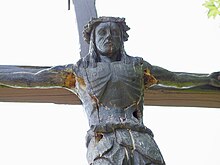Neuzeller pilgrimage song
The Neuzeller pilgrimage song Maria, Mutter, Friedenshort is a Catholic hymn.
History of origin
In German-speaking Silesia , the pilgrimage church in Grüssau Abbey was a popular and much-visited place of pilgrimage for Catholics until World War II . Thereafter, the German population was expelled from Silesia and the Archdiocese of Breslau was divided between Poland and Germany. Cities like Görlitz or Neuzelle were now on the German side, and the Archbishopric of Görlitz was therefore founded.
The numerous German expellees could no longer go on a pilgrimage to Grüssau. The expelled Catholic youths made a pilgrimage at the end of June 1947 at the suggestion of the Görlitz youth chaplain Heinrich Theissing to the Marienkirche of the former Cistercian monastery Neuzelle .
After this youth pilgrimage, Theissing asked his friend, Görlitz wood sculptor and poet Georg Schröter (1910–1986), to write a suitable pilgrimage song. He came from a humble background and was well acquainted with the circumstances of displacement, war, death and hunger, so that he was able to write a suitable text. Before the second pilgrimage in 1948, the music pedagogue Adolf Lohmann composed a melody for this song Maria, Mutter, Friedenshort , and Georg Schröter carved a pilgrimage cross that was carried by the young people from Görlitz to Neuzelle in 1948 and is still located on the hill of the Cross of the monastery in 1948 . It bears the inscription:
You
King
du
winner
see
our
Not
Built
by the
youth of the
Diocese
A 1948 D
In the years that followed, the eight stanzas of this Marian hymn text were particularly appreciated by those expelled from Silesia and were often sung. Since 1948, the song has not only been intoned on the annual pilgrimages of the diocese of Görlitz on Trinity Sunday. Finally it was included in the own part of the old praise of God for the GDR area. In the new Gotteslob it is located in the regional part of the East German dioceses under number 860, in the own part of the church province of Hamburg under number 903.
Text character
The text is not an undemanding utility song, but contains unusual and sophisticated formulations.
The first stanza addresses Maria as Regina pacis and as advocate , and in the second, fifth and seventh stanzas she is called upon as the addressee of intercessions. The third, fourth, sixth, and eighth stanzas consist of verses in praise and thanksgiving .
The final line of the third verse, "If your hand lifts the shadow, will give us a feast of mercy (n) days" denominated in Hamburg Hildesheim Osnabrücker own part falsely: "If your hand lifts the shadow, we will be a celebration of grace t r agen ".
Individual evidence
- ↑ a b c d Markus Bautsch: Neuzeller Pilgrimage Song , Mater Dolorosa (Berlin-Lankwitz) from May 2018, accessed on July 19, 2018
- ↑ Thomas Backhaus: Maria, Mutter, Friedenshort , Day of the Lord, Issue 35 (2008), accessed on July 19, 2018
- ↑ Markus Křesák: Good Friday in Görlitz , Diocese of Görlitz from March 31, 2018, accessed on July 19, 2018
- ↑ a b Rudolf Grulich: “Maria, Mutter, Friedenshort!” - The Neuzeller Pilgrimage Song , Nidda (2008), accessed on July 19, 2018

